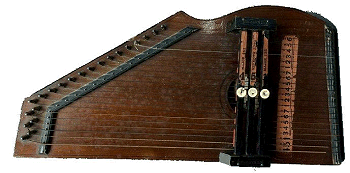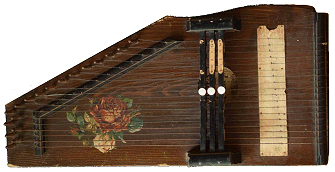


|
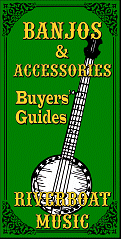
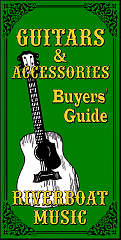
Hopf Autoharps
The German region of Saxony, along the Czech border, has been known for musical instrument building since the 1600s. The Hopf family has been part of that tradition since the beginning.We don't have a timeline for when, exactly, they started making autoharps, but the things were invented and first manufactured nearby, so it was likely around 1900, if not before.
What We Do Know: Early Autoharp History - Most Americans have been told that the autoharp was invented in Philadelphia by C.F. Zimmerman.
 But researchers have determined that the instrument we know as the autoharp was invented and patented by violin-builder Karl G?tter, of Markneukirchen, Germany at least two years before Zimmerman started manufacturing instruments of G?tter's design.
But researchers have determined that the instrument we know as the autoharp was invented and patented by violin-builder Karl G?tter, of Markneukirchen, Germany at least two years before Zimmerman started manufacturing instruments of G?tter's design.
The drawing to the right shows part of G?tter's patent application as it was processed in Britain in 1884, probably a year or two after G?tter's original patent in Germany was filed.
The 1882 patent label on some of Zimmerman's 'harps actually referred to an entirely different instrument that Zimmerman patented but never built. As far as we know now, Zimmerman - who frequently traveled to Germany - never built any kind of autoharp until after he saw G?tter's design.
Autoharps in Klingenthal - According to researcher Ivan Stiles, G?tter sold the patent rights to musical instrument purveyer Herman Lindemann from the nearby town of Klingenthal in 1883.
Where do the Hopfs come in? Klingenthal was also the home of the Hopf family, who had been building violins since the 1600s. We don't know if there was any relationship between the Hopfs and Lindemann, but we do know that autoharp building became widespread in the region almost immediately, so the Hopfs were certainly exposed to the things.
By 1890, Lindemann was complaining in writing about other folks building instruments (illegally) based on the patent he had bought from G?tter. However, we currently have no evidence that anyone in the Hopf family started building autoharps before G?tter's patent timed out. For one thing, an untimely death in the family may have put a damper on the family tradition of musical instrument building about 1884, just as autoharps were emerging.
About the Name Autoharp - Lindemann's complaint lists three names that were being applied to these instruments: "Volkszither," "Chordzither," and "Autoharp." Which is why Oscar Schmidt's 1926 attempt to trademark the name "autoharp" eventually failed - the name was proven to be in common use much earlier, so only the logo itself is trademarked.
Decades later, some of the autoharps of Hopf or suspected Hopf manufacture were called "ChordHarp," an apparent Anglicization of "Chordzither." During the GDR (East German) era, a few autoharps of Hopf design were labeled "Auto-Harp," which might have raised eyebrows, except that the East Germans weren't all that concerned about other folks' intellectual properties.
What We Know vs What We Surmise - I've patched the following chronology together from divergent, patchy, and sometimes conflicting accounts. I started to list them, but it just made this article even longer, unnecessarily IMHO.
As always, if you have specific knowledge of something I've missed or got wrong, please contact me and let me know.
About the Hopf Family - Apparently Caspar Hopf was a violin maker in or near Klingethal, in Saxony, in the late 1600s. For generations, his descendants continued to make stringed instruments - mostly violins - in the area.
Generally, the skill, as well as the "authorization" to put the name "Hopf" on their instruments, passed down from father to son in a nearly unbroken line. However, one of the patriarchs - August Harmann (1859-1884) - died young, potentially affecting the family business for a time. Ironically, this happened just as the autoharp was "catching on."
So if my "educated guesses" are correct, it's not likely that any Hopf autoharps date from before, say, 1901, when Carl Robert Hopf started his enterprise (below).
The Ernst Max Hopf/Max Willy Hopf/Dieter Hopf Branch - As I understand it, August Harmann Hopf's son, Ernst Max Hopf (1882-1956) subsequently learned to make violin strings. His son Max Willy (1906-1990) began building stringed instruments about 1932.
 In 1948, just before the GDR started nationalizing the industries in Saxony, members of that branch of the family moved to Taunusstein-Wehen, a small community in what was then "West Germany." They claim to have brought several of their craftspersons with them.
In 1948, just before the GDR started nationalizing the industries in Saxony, members of that branch of the family moved to Taunusstein-Wehen, a small community in what was then "West Germany." They claim to have brought several of their craftspersons with them.
In Taunusstein-Wehen, they operated under the name Willy Hopf & Co. According to one account, Dieter Hopf completed his training as a violin builder about 1958 and joined his father's company in that capacity. Violins, cellos, and other instruments from that era still turn up today.
Today the most visible remnant of that enterprise is the Dieter J. Hopf guitar company, noted especially for high-end guitars.
The Carl Robert Hopf/Arno Willy Hopf/Roland Hopf/J?rg Hopf Branch - But we seem to owe Hopf autoharps to another branch of the family. In 1901, Carl Robert Hopf (1871-1937) started building musical instruments in Brunnd?bra (now part of Klingenthal). That effort has been associated with zithers of all kinds ever since. Carl Robert was able to expand his factory considerably in 1918. It's unknown exactly when the factory started making autoharps, but Hopf's ability to mass-produce instruments increased dramatically.
Carl Robert's son Arno Willy Hopf became co-owner of the company in 1931 and continued ownership throughout WWII. Apparently several other Saxony-based musical instrument companies were allowed to continue making musical instruments throughout the war - an odd concession when nearly every other factory was turning out arms or military supplies.
Hopf Autoharps - Prewar - Countless zithers and autoharps that were probably made by the Hopfs before WWII have survived. An enthusiast who got his or her hands on the things would probably be able to verify each individually, but there's occasionally a question, because the name "Hopf" was often left off their instruments.
I can only comment on examples I've seen, seen in clear photographs, or own (just one). I certainly do not have anything like a complete list of models or the years they were produced, etc.
Many, if not most examples of early Hopf-style autoharps do not have a manufacturer name. For decades they put a rose decal on each one, leading to many of these instruments being called "Rosen," as though that was the manufacturer name. Folks who have had the chance to examine many of the instruments in this class have attributed nearly all of them to the Hopfs, but I don't have that advantage - relatively few have crossed the Atlantic.
Three-Chorders - As you can see in the photos below, both Zimmerman and the Hopf family started out with something very close to G?tter's design, shown above. Don't be too distracted by the relatively narrow body on the Hopf version - Zimmerman also started making his harps narrower by the time he went to 5-chord versions.
 Six-Chorders - The walnut-toned autoharp to the right probably represents the next step in Hopf autoharp development. It's very similar to the 3-chord version above, but takes advantage of the relatively long strings to add three more chords. String count goes from 18 to 24, but they are still diatonic as far as I can determine.
Six-Chorders - The walnut-toned autoharp to the right probably represents the next step in Hopf autoharp development. It's very similar to the 3-chord version above, but takes advantage of the relatively long strings to add three more chords. String count goes from 18 to 24, but they are still diatonic as far as I can determine.
Here is where the divergence from US-built autoharps starts to become more obvious. Although the construction is nearly identical to the US-built Zimmerman/Dolge "Favorite," the chords are different and the labeling becomes increasingly more confusing to US enthusiasts.
The chord bars of the 5-chord, 22-string "Favorite," as well as almost all other 5-chord US-built Autoharps, have Bb, C7, F, G7, and C, which would allow you to play 3-chord songs in F or C. (Their labeling is confusing, but, don't worry, nobody uses that labeling convention any more.)
The chord bars of the 6-chord Rosens I've seen so far are C, D7, G, Em, Am, and Bm. (Their labeling is also confusing. Again nobody uses those labeling conventions any more either.)
Note that US-built Autoharps tended to add more flat keys than sharp keys, starting with C and working their way further into flats as chords were added. (For example American 5-chorders can play in C and F, but not in G.)
On the other hand, the 6-chord Rosen autoharps shown above and below could only play in G, though they could play nearly any song written in that key, thanks to the addition of minor chords that were missing from almost every US built autoharp until many decades later. So if you want an autoharp to jam with your Bluegrass banjo-loving friends, this might be the one. :-)
 I currently own one instrument of this class, a little six-chord, 25-stringed instrument similar to the photo to the right (mine is still in the same terrible shape in which I received it, so I'm not going to share a photo yet). As an aside, mine has the buttons straight across, an earlier configuration, but otherwise construction seems identical to this one.
I currently own one instrument of this class, a little six-chord, 25-stringed instrument similar to the photo to the right (mine is still in the same terrible shape in which I received it, so I'm not going to share a photo yet). As an aside, mine has the buttons straight across, an earlier configuration, but otherwise construction seems identical to this one.
It's also black like this one, a convention Hopf may have adopted after US-built Autoharps started coming out in black finish.
Interestingly enough, the construction methods are virtually identical to contemporary US-built Autoharps like "The Favorite" (5-chorder) and Model 7 (8-chorder). To me that's a sign that the two manufacturers were still sharing designs - officially or not - for several decades after the autoharp was introduced.
The decals are often the main indicators. If the decal shows a lady with a harp (and maybe a cherub), it's probably US-built. If you see roses, it's probably a Hopf.
 Nine-Chorders - Some of my "detective work" has involved tracking down photos of rare gear that sold years ago on obscure auction sites, Etsy links, etc. I always try to get back to the original so I can give credit, and hopefully find a high-resolution photo. But it's not always possible.
Nine-Chorders - Some of my "detective work" has involved tracking down photos of rare gear that sold years ago on obscure auction sites, Etsy links, etc. I always try to get back to the original so I can give credit, and hopefully find a high-resolution photo. But it's not always possible.
In some of these searches, I have come across a nine-chord Rosen autoharp. It seems to have 32 strings, but it is not as "chromatic" as the US equivalent. The only "black keys" are F# and C#. (The contemporary 8-chord US-built Model 7 7/8 also has 32 strings, and it is chromatic in the middle and high octaves.)
As far as I can determine from photographs, this Rosen's chords are C, D7, G, Em, Am, Bm, G7, A7, and D. This would enable you to play most songs in G and D. (If I had one, I'd be sorely tempted to re-felt the G7 as an F#m, so you could play even more songs in D. G7 is almost useless in a harp that doesn't play songs in C anyway. Unless you're into Blues.)
In contrast, the US-built Model 7 7/8, with the chords Bb, F, C, C7, G7, A7, Gm, and Dm, could play most songs in F and many songs in C. So the US makers' tendency to go toward flats and the German makers' tendency to go toward sharps continued.
 More Chord Name Confusion - If you try to read the chord names on the Hopf 9-chorder, you'll notice that what we call B is labeled H (a German convention), but even more confusing is the use of the Alphabet across the top, presumably to help you put the chord bars back in sequence if you take them out to clean the thing or check the felts. This has led to folks asking "What kind of note is an 'I'?" Or, on Hopf autoharps with 12 chords, a "J," "K," or "L"?
More Chord Name Confusion - If you try to read the chord names on the Hopf 9-chorder, you'll notice that what we call B is labeled H (a German convention), but even more confusing is the use of the Alphabet across the top, presumably to help you put the chord bars back in sequence if you take them out to clean the thing or check the felts. This has led to folks asking "What kind of note is an 'I'?" Or, on Hopf autoharps with 12 chords, a "J," "K," or "L"?
The chord names are in lower case on the second row. Major is indicated by "dur" or "maj." Seventh is indicated by "sept." And minor is indicated by "moll" or "min." Clear as mud?
 Twelve-Chorders - Meanwhile, across the Atlantic, the US-built Model 73 Autoharp was on the brink of becoming the best-selling autoharp of all time. 37 strings, 12 chords, and mostly chromatic.
Twelve-Chorders - Meanwhile, across the Atlantic, the US-built Model 73 Autoharp was on the brink of becoming the best-selling autoharp of all time. 37 strings, 12 chords, and mostly chromatic.
So the Hopfs issued an autoharp that looked so much like a Model 73, that they still occasionally fool people today, especially the later versions without the roses.
 But it didn't play like a Model 73. As far as I can tell from a photograph of another surviving instrument, the chord bars, left to right, are C, D7, G, Em, Am, Bm, G7, A7, D, F, Dm, F#m - an arrangement that makes very little sense from a musician's perspective.
But it didn't play like a Model 73. As far as I can tell from a photograph of another surviving instrument, the chord bars, left to right, are C, D7, G, Em, Am, Bm, G7, A7, D, F, Dm, F#m - an arrangement that makes very little sense from a musician's perspective.
Again, ignore the alphabet at the top of the labels - that's just to help you replace the chord bars in the right order if you take them off for cleaning or repair.
That said, it is still not a chromatic - the only "black keys" being F# and C#.
With this harp, the Hopfs have added the ability to play virtually every song in the key of C, while retaining the ability to play in G and D. (The US-Built Model 73 could play most songs in F and C, as well as three-chord songs in the key of G.)
 As a Folksinger myself, the Hopf 12-chorder would be much more useful, though I would probably rearrange the chord bars to a more logical sequence. And I'd find E7 more useful than G7.
As a Folksinger myself, the Hopf 12-chorder would be much more useful, though I would probably rearrange the chord bars to a more logical sequence. And I'd find E7 more useful than G7.
A little later in history, probably due to the Communist takeover of "East Germany" (see below), these lost the black paint, the rose decal, and the Hopf labeling. Names like "Auto-Harp" and "Chord-Harp" took over.
Though the harp in the photo to the right has been shabbily treated, some harps from this era have survived in good condition, and the owners tell me they are a delight to play. (In case you wondered, they are still not chromatic - string and chord-wise, they are identical to the Rosen version.)
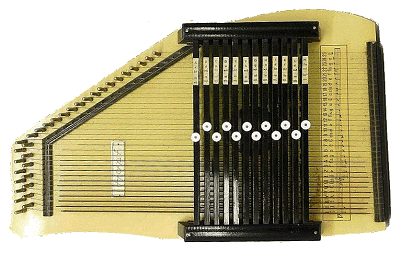 Some of these were produced in a lighter finish, such as the "blond" harp to the right. There is also a warmer, pecan-like finish, but unfortunately, I haven't found a clear photo yet.
Some of these were produced in a lighter finish, such as the "blond" harp to the right. There is also a warmer, pecan-like finish, but unfortunately, I haven't found a clear photo yet.
Harps like the one on the right are hard to date, because they have lost the black paint and rose, but they retain the family name. They may have been made during the early GDR before Musima took over completely, but I have not come across an authoritative source to pinpoint a date or even a range of dates.
One thing is certain; they are not being made today.
Fifteen-Chorders - This is where the history gets even hazier than it has been so far. The Hopf-built 15-chorder that first brought my attention to this family of instruments (and instrument builders) was probably produced either just before, during, or just after WWII. Like the 21-chorders that Oscar Schmidt's company eventually built, these had chord bar covers and pushbuttons.
 Some of them, like the thumbnail shown to the right, turn up labeled "Hopf," but most of them turn up labeled "Musima" a brand name forced on the Saxony-based musical instrument manufacturers by the postwar Communist regime (see below.)
Some of them, like the thumbnail shown to the right, turn up labeled "Hopf," but most of them turn up labeled "Musima" a brand name forced on the Saxony-based musical instrument manufacturers by the postwar Communist regime (see below.)
It's possible that the ones labeled "Hopf" were manufactured before or during the war, or just before the GDR mandated a brand name change about 1960. But I won't make any firm claims until I have better sources than the collectors or online sellers who really have no idea when the individual harp in their possession was actually built.
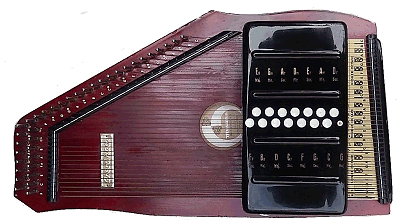 The best photo I have of one of these was obviously built during tight GDR restrictions, as indicated by the name Musima and the lack of the Hopf name or any other identifying characteristics. But clicking on the photo will show you lots of details that make this harp interesting. Most especially the chord bar buttons and cover. In addition, I believe this is the first Hopf-designed autoharp that is truly chromatic (in the upper two octaves at least).
The best photo I have of one of these was obviously built during tight GDR restrictions, as indicated by the name Musima and the lack of the Hopf name or any other identifying characteristics. But clicking on the photo will show you lots of details that make this harp interesting. Most especially the chord bar buttons and cover. In addition, I believe this is the first Hopf-designed autoharp that is truly chromatic (in the upper two octaves at least).
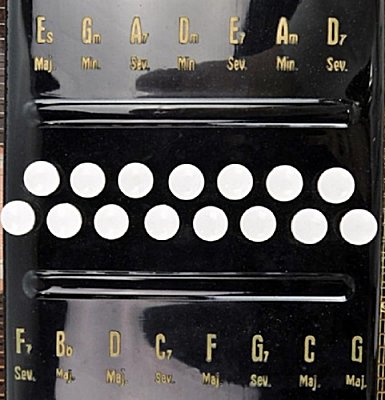 To my knowledge this is the first Hopf-designed autoharp that enabled playing in F and Bb. This brings the Hopf-built autoharps more into line with the Oscar Schmidt 15-chorders, which could play most songs in Bb, F, and C, and three-chord songs in G and D. (Unfortunately for Folkies, it loses Em, Bm, and F#m, so it's not as useful for jamming with Folk or Bluegrass players as the old 12-chord version.)
To my knowledge this is the first Hopf-designed autoharp that enabled playing in F and Bb. This brings the Hopf-built autoharps more into line with the Oscar Schmidt 15-chorders, which could play most songs in Bb, F, and C, and three-chord songs in G and D. (Unfortunately for Folkies, it loses Em, Bm, and F#m, so it's not as useful for jamming with Folk or Bluegrass players as the old 12-chord version.)
Don't let the Es label at the top left throw you off. That is German for Eb. Ironically Bb, which the Germans might ordinarily call "B" is labeled Bb, probably as a convenience for non-Germans. Confused yet?
The chord arrangement is not the most logical, but neither is the chord arrangement on the contemporary Oscar Schmidt 15-chorders. Frankly, both of them place the D chord bar in an awkward position.
Communist Takeover
Sadly, in 1950, the GDR's communist leaders declared Arno Willy an enemy of the state, which gave them an excuse to put him in prison for 27 months and "nationalize" his shares of the company. By 1960, those shares were transferred to "VEB Musima Markneukirchen," the "cooperative" that the GDR set up so it would look like the Saxony music factories were all part of one big happy family. That may have included other musical instrument companies that were said to have operated during the war, including Heinz Rauner, Rudi Schuch, and Fischer. Unfortunately, I have no information to speak of on those entities or whether any survived the war or the Musima era in any meaningful way.
What I can say with reasonable confidence, is that the Hopf machinery and perhaps some number of the Hopf employees and even family members continued to make zithers and autoharps identical to the pre-war and WWII-era Hopf instruments.
Many of the brown and light-finish 12-chorders may date to that era. As shown by the "Musima" label in the photo of the 15-chorder above, many of the 15-chorders do, too.
The rose decals went away from the autoharp line and never came back. Labels that say "Chord Harp" or "Auto Harp" may have appeared about this time.
The much larger chorded zither line also lost its roses. However those roses were replaced by wildflower decals, a motif that was still in use decades later.
In 1972, what was left of the Carl Robert Hopf company was completely nationalized, into "VEB Musima." It's hard to know for certain which autoharps and zithers were made during that era, but it's certain that manufacturing continued. Most were exported to countries in Western Europe, as well as Australia. Apparently by that time, communist control was so extensive that they were virtually made with "slave labor," which made them very cheap compared with instruments made in the West. Of course, any profits would have gone to "the collective," so the craftspeople would not have benefited from better prices at any rate.
The nationalized "Musima" factories produced other instruments besides zithers and autoharps, including electric guitars. For more information about the Musima factories and the instruments they produced, please visit our Musima Autoharps article.
Reunification and Return to Family Control Immediately upon Germany's reunification in 1990, the Hopf family sued to regain control of what had been their family business.
In 1992, after a prolonged and stressful effort on the part of Roland Hopf, the company name and at least some of its assets were returned to the heirs of the Hopf family. Germany also "vacated" the GDR's claim that Arno Willy had been an enemy of the state, which had "justified" communist takeover of the company in the first place.
Sadly, Roland Hopf died two years later. J?rg Hopf continued as a sole proprietor. The present owner (as of September, 2021) is listed on their web page as Tetyana Hopf.
According to the company's web page, they are the last manufacturers of stringed instruments in Klingenthal, which once boasted scores of instrument builders and several successful companies. Frankly, that's a sad ending to what was once a vast musical heritage of the region, but I'm glad that at least one of the family businesses survived the harrows of the 20th century.
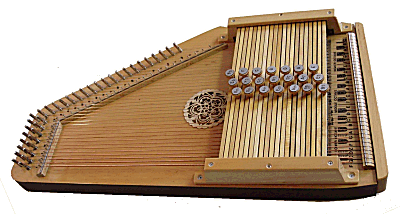 Today the C. Robert Hopf company sells many models of zither and at least one nice 21-chord autoharp. Not only does it look very nice, but the instrument is "Folk-Friendly." That is, the chord bars are arranged in a logical sequence, based mostly on the "circle of fifths," and it replaces some of the flat-friendly chords with Folk-friendly chords like F#m and Bm.
Today the C. Robert Hopf company sells many models of zither and at least one nice 21-chord autoharp. Not only does it look very nice, but the instrument is "Folk-Friendly." That is, the chord bars are arranged in a logical sequence, based mostly on the "circle of fifths," and it replaces some of the flat-friendly chords with Folk-friendly chords like F#m and Bm.
Ironically, nobody in the Hopf family line of businesses seems to be making violins, their centuries-long focus before WWII.
Other Possible Hopf Enterprises - Researching this is a little difficult because each branch of the Hopf family seems to portray themselves as if they're the only true heirs to the ancient Hopf family musical instrument-building traditions. In scouring the internet for Hopf-built instruments, I have come across a few mid-to-late 20th century examples labeled "Hopf" that seem to be outside the scope of either of the two families named above.
So you may very well come across something labeled Hopf that is not:
- A guitar (probably the Willy Hopf/Dieter Hopf branch),
- A zither or autoharp (probably the Carl Robert Hopf/Arno Willy Hopf/Roland Hopf/J?rg Hopf branch), or even
- A pre-1900 member of the violin family (most Hopfs before 1900).
If you do, please let me know, and I'll do what I can to connect the dots.
Conclusion
Although some folks complain that Musima-era autoharps and zithers show less evidence of quality control (and quality materials) than earlier and later instruments, most folks who have come up with the autoharps and the better zithers from the GDR era have found them delightful (once they figured out the chord labeling system).I do know that the old 6-chord Rosen I have was as well-built as its US-built contemporaries. If it wasn't for the rose decal and unusual chord setup, you'd probably mistake it for a "Zimmerman" model.
Because of their sharp-friendly chord choices, the 9- and 12-chord versions would be especially interesting to folks who play Folk or Bluegrass. And those that haven't been abused have a lot of good music left in them.
Chances are very good that the Hopfs made other models, which we haven't seen yet. If you come across one, please get in touch and we'll be glad to share your "find."
Also, if you are a former Hopf or Musima-factory craftsperson and you want to share any of your experiences, I would be VERY glad to hear from you.
 Whatever else you get out of our pages, I hope you come away with some great ideas for "sharing the joy."
Whatever else you get out of our pages, I hope you come away with some great ideas for "sharing the joy."
And please stay in touch!
All material, illustrations, and content of this web site is copyrighted ? 2001, 2002, 2003, 2004, 2005, 2006,
2007, 2008, 2009, 2010, 2011, 2012, 2013, 2014, 2015, 2016, 2017, 2018, 2019, 2020, 2021 by Paul D. Race. All rights reserved.
Creek Dont' Rise(tm) is a participant in the Amazon Services LLC Associates Program, an affiliate advertising
program designed to provide a means for sites to earn advertising fees by advertising and linking to Amazon.com.
For questions, comments, suggestions, trouble reports, etc. about this page or this site, please contact us.
|
How To Help Our Site for Free: If you find our tips, explanations, and recommendations helpful when picking out a product, and you appreciate that we don't continually inconvenience you with irrelevant ads or obnoxious popups, Please Bookmark This Page and come back through it when you're ready to order. It costs you nothing, and we never see who placed the order, so you don't have to worry about us pestering you with followup e-mails or some such. But it helps us know what pages you find useful, and it helps our advertisers know who to support.
And that, in turn, helps us provide more useful resources. Thank you! |
| Visit related pages and affiliated sites: | |||||
| - Music - | |||||

|
 |
 |

|

|

|

|

|

|

|

|

|

|

|

|

|

|

|
| - Trains and Hobbies - | |||||
 |

|

|  |
 |

|
| - Christmas Memories and Collectibles - | |||||
 |

|
 |

|
 |

|
| - Family Activities and Crafts - | |||||
 |

|

|

|

|

|
